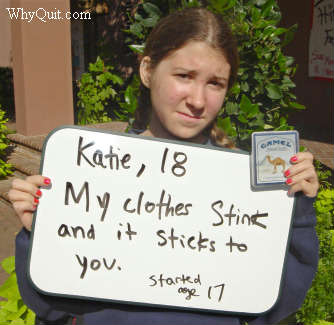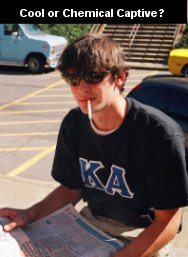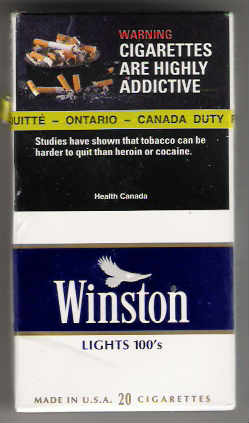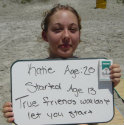
Enslaved college smokers pay hefty price
 Who wants to befriend, date, marry or hire a drug addict? Not only are dependent college and university students forced to daily wear the stink and stigma of their addiction to smoking nicotine, a new survey reports that university student smokers are five times more likely than non-smokers to believe that their physical fitness is declining.
Who wants to befriend, date, marry or hire a drug addict? Not only are dependent college and university students forced to daily wear the stink and stigma of their addiction to smoking nicotine, a new survey reports that university student smokers are five times more likely than non-smokers to believe that their physical fitness is declining.
An October 2009 online version of a Greek study, to be published in the journal Environmental Health and Preventive Medicine, surveyed 1,205 students, which included 269 medical students and 936 university non-medical students. It found that 640 students were non-smokers while 565 currently smoked.
The nicotine addiction industry works hard to keep these 565 student smokers convinced that they smoke for flavor and pleasure, that smoking's negative health effects are decades away from being felt, that there's plenty of time to quit, and that new quitting products make quitting easy. Smoking's truths and realities paint a vastly different picture.
According to the study, three times as many smoking students reported a cough as non-smoking students (51% vs. 16%), half as many engage in at least one hour of heavy exercise daily (8 vs. 16%), and while 13% of smokers reported at least 2 respiratory infections during the prior year, the rate among non-smoking students was only 8%.
 The 3,650 cigarettes smoked annually by a 10 cigarette per day student smoker marinates darkening lung tissues in one-half cup of tar per year. The tar is composed of thousands of chemicals that include scores of toxins and up to 81 cancer causing chemicals. Undiluted cigarette tar painted on the skin of mice cause 60% to develop cancer within a year.
The 3,650 cigarettes smoked annually by a 10 cigarette per day student smoker marinates darkening lung tissues in one-half cup of tar per year. The tar is composed of thousands of chemicals that include scores of toxins and up to 81 cancer causing chemicals. Undiluted cigarette tar painted on the skin of mice cause 60% to develop cancer within a year.
While slowly painted carginogen time-bombs within smokers normally but not always take three or more decades before exploding, 90% of inhaled smoke remains inside the lungs, where airway inflammation and congestion often begin to imitate what's normally lung cancer's earliest warning sign, a chronic cough.
While 51% of smoking students in this study reported coughing, the amount smoked daily was fairly evenly spread between light, average and heavy smokers. Among all smoking students, 35% smoked less than 10 cigarettes per day, 38% smoked 10 to 19, and 28% smoked 20 or more daily.
Keep in mind that many of the light smokers are new smokers. Over time, growing brain tolerance to nicotine will compel most to smoke each cigarette a bit harder, to take additional puffs, to hold the smoke longer or smoke more cigarettes in order to sense relief from mounting anxieties felt when enslaved dopamine pathways go too long without chemical stimulation.
 What's fascinating about the Greek study is the high percentage of smoking
students -- 68.5% -- who sense and openly admit that their physical
fitness has already declined. They may want to run long distances or engage in prolonged periods of vigorous physical activity but their addiction to smoking nicotine simply won't permit it.
What's fascinating about the Greek study is the high percentage of smoking
students -- 68.5% -- who sense and openly admit that their physical
fitness has already declined. They may want to run long distances or engage in prolonged periods of vigorous physical activity but their addiction to smoking nicotine simply won't permit it.
One-half of the carbon monoxide inhaled with that last puff is still circulating inside their bloodstream four hours later. It deprives their heart and lungs of their blood's natural oxygen carrying capacities. It isn't that the addicted student doesn't want to run like the wind. It's that they can't.
Trapped within a tobacco farming and use culture, Greece has one of the highest per-capita cigarette consumption rates in the world. More than 50% of 4th year medical students in this study reported current smoking. Other studies suggest that roughly 40% of Greek adults (their soon to be patients) report daily smoking. Imagine attempting to counsel patients on quitting when you yourself are addicted.
Clearly, existing medical education is no match for either tobacco industry marketing or true chemical dependency. But the Greek government isn't alone in playing directly into the tobacco industry's marketing campaign by focusing on long-term risks while ignoring dependency's immediate consequences.
Once secret tobacco industry documents assert that part of the lure for students is the excitement associated with taking risks. A 1991 Philip Morris youth marketing memo teaches executives to "insist that smoking is dangerous," that "smoking is for people who like to take risks, who are not afraid of taboos, who take life as an adventure."
While a rash of recent studies demonstrate that it may only take smoking 1 or 2 cigarettes before the brain begins up-regulating the number of nicotinic receptors and the student begins experiencing loss of autonomy, far too few school, university, health and government websites currently share these critical findings with students.
University health educators and college student addiction counseling centers have long been aware that the nicotine addiction industry actually targets students, using free samples at popular local night clubs and spring break destinations as bait to hook and enslave them. They know that industry convenience store marketing grows more intense the closer you get to campus. But if happening at your college, when is the last time you heard about an organized protest to try and change things? Probably never.
using free samples at popular local night clubs and spring break destinations as bait to hook and enslave them. They know that industry convenience store marketing grows more intense the closer you get to campus. But if happening at your college, when is the last time you heard about an organized protest to try and change things? Probably never.
How many seconds of freshman orientation does your college or university devote to warning incoming students that the nicotine industry has targeted them for chemical captivity? How many will view slides of already hooked students holding signs warning of experimentation's price?
Reflect on the math and sanity of investing four years in a college education, where addiction to smoking nicotine during your freshman year saddles you with 50% odds of killing yourself, your education and dreams 13-14 years early. But according to industry marketing hype, if you are among the 90% of regular users who soon find themselves addicted, quitting is easy, right?
What percentage of nicotine gum and patch users succeed in quitting smoking for at least 6 months? Sadly, both pharmaceutical and tobacco industry marketing falsely lead students to believe that these products are highly effective at helping smokers quit. It's untrue. A March 2003 study by pharmaceutical industry consultants found that 93% of nicotine patch and gum users relapse to smoking within 6 months.
When quitting there's up to 72 hours before physical withdrawal peaks in intensity, a brief emotional train wreck while the brain works to restore natural sensitivities, less than 3 minute crave episodes upon encountering each conditioned smoking cue, and weeks or months of conscious thought fixation as we wade through all the lies we fed ourselves as to why we smoked. Truth is, nicotine dependency recovery may be the greatest challenge we'll ever face. In fact, it's so challenging that each year an estimated five million smokers smoke themselves to death. Sadly, roughly half of college daily smokers already know the cause of death that will be printed on their death certificate: smoking.
It just doesn't hit us as students how nicotine addiction is as permanent as alcoholism. A 1989 government survey found that among high school seniors smoking 1 pack of cigarettes a day, that while less than 1 percent expected to be smoking in 5 years, that 5 years later 87 percent were still smoking. Among seniors smoking less than 1 cigarette a day at graduation, 42 percent were still smoking 5 years later.
Among the 565 Greek student smokers, 44% of smoking medical students and 36% of undergraduates had already attempted to quit at least once and failed.
Truth is, smoking nicotine is extremely addictive and dependency's price is massive, immediate and as permanent as alcoholism. Our addiction determines how we smell, what we're able to smell and taste, how long and vigorously we can exercise, our primary circle of friends, who'll want to date us, how many employers will want to hire us, the condition of our lungs, how often we'll get sick, the intensity of stress, how fast our heart beats, the depth and duration of relaxation, our priorities, and when we'll stand outside in the rain, heat or cold.
Who wants to look in the mirror and see a true drug addict looking back? While admitting where we find ourselves dramatically enhances our odds of doing something about it, instead we invent a laundry list of rationalizations as to why we must smoke that next fix.
We can buy into tobacco industry marketing lies that we smoke for taste, or awaken to the realization that there are zero taste buds inside human lungs. We can buy into the lie that smoking is an adult activity or realize that almost all adult smokers became addicted while children or teenagers.
We can continue to believe the fiction that smoking nicotine relieves stress. In truth, nicotine dependency adds the onset of withdrawal to every stressful situation college life throws your way. Nicotine is an alkaloid and stress an acid generating event within the body. Have you ever watched the bubbling and neutralization that occurs when a baking soda solution (an alkaloid) is poured over an acid covered car battery terminal? Imagine the beauty of no longer adding nicotine withdrawal's onset atop every stress generating event.
We can pretend we smoke for "pleasure" or admit that we do so because we must, because the onset of early withdrawal and a rising tide of anxieties begin to hurt when we don't. It isn't that we liked smoking but that we don't like what happens when we don't.
College rationalizations are the easiest to sell. There's homework, papers, quizzes, tests and exams. "It's just too stressful right now!" "I'll quit after exams," "during break," "over the summer," "before graduation."
Before you know it, a still feeding nicotine addict is walking across a stage and handed a college diploma. And then it's, "I've got to find a job!" "Work's just too stressful right now!" "I'll quit on vacation," "my next birthday," "New Year's day," "before the wedding," "after the baby's born," "by the time I'm 30," "by 40!" "Oh my God, doctor. Tell me you're just kidding!"
While ignorance of truth is what allowed us to get hooked in the first place, knowledge and understanding are key to breaking free. While we'll never be stronger than nicotine, we don't need to be as it's only a chemical with an IQ of zero. It cannot think, plan, plot or conspire and is not some demon or monster that dwells within. The secret to arresting our dependency and staying free is to become smarter than our addiction is strong.
Like all drug addictions, once we stop using, there is only one rule to staying free: NONE (NO Nicotine Ever). Just one puff and within 10 seconds up to 50% of our brain's a4b2-type nicotinic receptors will become occupied by nicotine. While we'll likely walk away from relapse thinking we've gotten away with it, as surely as the sun rises in the sky our brain will soon be begging for more. There was always only one rule ... no nicotine just one hour, challenge and day at a time, never take another puff, dip or chew!


















